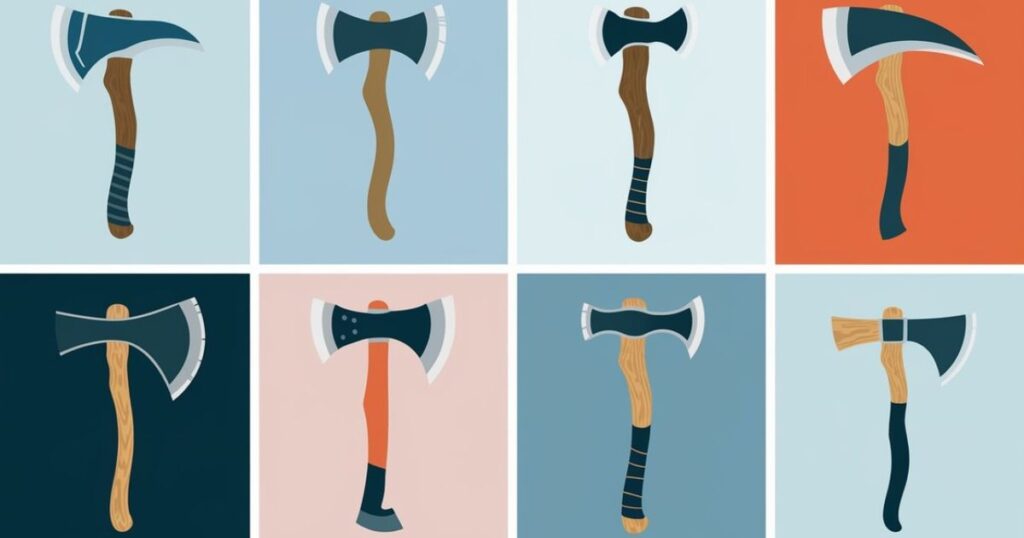Axes are handy tools that have been used for thousands of years. They have changed from simple stone tools to modern designs we see today. Whether you’re a lumberjack, a camper, or someone who likes DIY projects, knowing about different axes can help you work better.
Each type of axe, like the felling axe or hatchet, has its own special use. In this article, we will look at various types of axes, their history, and how to use them. Learn how choosing the right axe can make your woodwork, camping, or survival tasks much easier.
Understanding Axes: A Brief History
An axe is a hand-held tool with a sharp blade attached to a long handle. It is used for chopping, cutting, and splitting wood. The design allows for powerful swings, making it effective for various tasks. Axes come in different shapes and sizes, each suited for specific functions.
Axes have been used for thousands of years, dating back to prehistoric times. Early axes were made from stone and were essential for survival. As civilizations advanced, axes evolved in design and material, moving from stone to bronze and then iron. They served important roles in agriculture and warfare.
Evolution of Axes Through the Ages
The evolution of axes reflects technological advancements. Initially, axes were simple stone tools for chopping. With the rise of metalworking, bronze axes offered better durability.
In the Middle Ages, axes became specialized for tasks like felling trees and combat. Today, axes feature ergonomic designs and modern materials, catering to both professionals and outdoor enthusiasts. They continue to be versatile tools in various fields.
Key Factors to Consider When Choosing an Axe
Choosing the right axe involves several key factors that can impact its performance and suitability for your needs.
Handle Material and Design
The handle material plays a crucial role in the axe’s durability and comfort. Common materials include wood, fiberglass, and steel. Wooden handles, often made from hickory or ash, provide a traditional feel and good shock absorption.
Fiberglass handles are lightweight and resistant to moisture, while steel offers maximum strength. The design of the handle should promote a comfortable grip, reducing fatigue during extended use. Ergonomic designs can enhance control and efficiency.
Weight and Balance
Weight and balance are critical for effective use. Heavier axes are generally better for chopping and splitting, as they provide more power with each swing. They can also lead to fatigue if used for prolonged periods.
A well-balanced axe allows for easier handling, improving accuracy and reducing strain. When selecting an axe, consider how it feels in your hand, and ensure it aligns with the tasks you intend to perform.
Function and Use
Understanding the specific function of the axe is essential for making the right choice. Different axes are designed for various tasks, such as felling trees, splitting wood, or carving.
Determine the primary use of the axe—whether for outdoor activities, construction, or specialized tasks. This understanding will guide you in selecting the right type and design to meet your needs effectively.

Types of Axes
Axes are versatile tools with a rich history, used for various tasks across different cultures. From the powerful felling axe, designed for cutting down trees, to the compact hatchet, perfect for smaller chopping tasks, each type serves a unique purpose.
The Viking axe showcases traditional craftsmanship, while the tactical axe combines modern design with functionality for survival scenarios.
Specialized axes like the splitting maul efficiently split logs, while the carpenter’s axe is tailored for precise woodworking. The ice axe is essential for climbers navigating icy terrains, and the throwing axe adds a recreational element to the tool family.
Understanding these diverse types of axes helps enthusiasts choose the right tool for their specific needs, whether for outdoor activities, construction, or historical appreciation.
Hudson Bay Axe
The Hudson Bay Axe is a classic tool with a rich history. It was primarily used by fur traders in the 17th century. This axe features a wide blade and a long handle, making it effective for various tasks.
The design allows for efficient chopping and splitting of wood. The curved blade helps in precise cuts and can even serve as a hammer when needed. Its versatility makes it a favorite among campers and outdoor enthusiasts today.
In addition to its practical uses, the Hudson Bay Axe is often appreciated for its craftsmanship. Many modern versions retain the traditional design while using updated materials. This axe remains a reliable choice for anyone who enjoys outdoor activities.
Tactical Axe
A tactical axe is a versatile tool designed for various survival and combat situations. It combines the features of an axe with elements suited for tactical use. Typically, it has a sturdy, lightweight design that enhances portability.
The blade of a tactical axe is often made from high-carbon steel, ensuring durability and sharpness. Many models also include additional features, such as a pointed tip for piercing and a textured handle for better grip. This makes it suitable for chopping, cutting, and even self-defense.
Tactical axes are popular among military personnel, outdoor enthusiasts, and survivalists. They can be used for chopping wood, clearing brush, or as an emergency tool.
The combination of functionality and compact design makes the tactical axe an essential tool for anyone who values preparedness in outdoor or survival scenarios.
Grub Axe
The grub axe is a specialized tool designed for digging and uprooting. It features a heavy, broad blade that allows for efficient cutting through tough soil and roots. This axe is particularly useful in gardening, landscaping, and forestry work.
The blade is often angled, which helps in precision cutting and makes it easier to maneuver in tight spaces. The handle is typically longer than that of a standard axe, providing better leverage when digging or breaking ground. This design reduces the effort needed to penetrate hard or compacted soil.
Grub axes are favored by gardeners and professionals for tasks like removing stumps, digging trenches, and clearing roots.
Their rugged construction ensures they can withstand heavy use, making them reliable for various outdoor projects. Overall, the grub axe is a valuable tool for anyone looking to manage tough ground conditions effectively.
Felling Axe
The felling axe is specifically designed for cutting down trees. It features a sharp, tapered blade that allows for efficient penetration into wood. This axe typically has a long handle, providing the necessary leverage to swing with force.
Felling axes are used primarily in forestry and logging. The design of the blade helps create clean cuts, reducing the risk of damaging surrounding trees. They are effective for felling medium to large trees, making them essential for anyone working in wooded areas.
The weight of the felling axe plays a significant role in its effectiveness. Heavier axes can chop through tougher wood, while lighter versions are easier to handle for extended periods. Many modern felling axes also have ergonomic handles to improve comfort and reduce fatigue during use.
Overall, the felling axe is a crucial tool for anyone involved in tree removal or forestry activities, known for its efficiency and durability.
Forest Axe
The forest axe is a versatile tool designed for various tasks in wooded environments. It typically features a sturdy blade with a wide cutting edge, ideal for chopping and splitting wood. The design often combines elements of both a felling axe and a hatchet, making it suitable for a range of activities.
With a longer handle than a hatchet, the forest axe provides better leverage and power for chopping larger logs. The blade is usually well-balanced, allowing for precision and control during use. This makes it effective for tasks like clearing brush, cutting firewood, and even carving.
Forest axes are popular among campers, hikers, and survivalists for their practicality. Many modern versions are crafted from high-quality steel, ensuring durability and sharpness. Additionally, the lightweight design makes it easy to carry on outdoor adventures.
Overall, the forest axe is an essential tool for anyone spending time in nature, combining functionality and ease of use for various wood-related tasks.
Hatchet
The hatchet is a small, versatile hand tool used for chopping, splitting, and cutting. Its compact size makes it easy to carry, making it a favorite among campers, hikers, and survivalists. A typical hatchet features a sharp, single-bit blade designed for various outdoor tasks.
With a shorter handle than larger axes, the hatchet allows for better control and precision. This makes it ideal for preparing kindling, trimming branches, or light carving. Many hatchets have a curved blade, which enhances slicing efficiency.
Hatchets are often made from high-carbon steel for durability and sharpness. The handles are usually crafted from wood or fiberglass, providing a comfortable grip. Some designs also feature a hammer poll, adding to their functionality.
The hatchet’s portability and ease of use make it an essential tool for outdoor enthusiasts. It is reliable for a range of chopping and cutting tasks, whether in the backyard or deep in the woods.
Splitting Maul
The splitting maul is a heavy-duty tool specifically designed for splitting wood. It features a large, wedge-shaped blade that efficiently splits logs along the grain. The maul is heavier than a traditional axe, allowing it to deliver more force with each swing.
The long handle provides leverage, making it easier to split even the toughest wood. The design typically includes a flat side opposite the blade, which can be used for driving wedges into the wood. This dual functionality enhances its efficiency for larger tasks.
Splitting mauls are commonly used in wood preparation for fires or woodworking. They are ideal for tackling thick logs and large pieces of firewood. The sturdy construction ensures durability, making it suitable for frequent use.
For anyone involved in outdoor activities or wood processing, a splitting maul is an essential tool. Its ability to handle tough splitting tasks with ease makes it a reliable choice for preparing firewood or managing larger logs.
Broad Axe
The broad axe is a traditional woodworking tool designed for shaping and hewing logs. It features a wide, flat blade that allows for precise cuts and shaping of wood. The design is typically angled, which helps in creating flat surfaces on beams and planks.
Broad axes are often used in timber framing and boat building. Their wide blades make them ideal for removing bark and flattening surfaces, enabling craftsmen to create strong, level pieces. The handle is usually longer than that of a standard axe, providing better control and leverage during use.
This tool is particularly effective for working with hardwoods, as its weight and design can help in making deep cuts with less effort. Many broad axes are made from high-carbon steel, ensuring durability and sharpness for extended use.
For anyone involved in woodworking or construction, the broad axe is a valuable tool. Its versatility and effectiveness in shaping wood make it a preferred choice among artisans and builders.
Carpenter’s Axe
The carpenter’s axe is a specialized tool designed for woodworking. It features a thin, sharp blade for precision cuts, making it ideal for shaping and trimming wood. The design typically includes a flat side, allowing the axe to be used for striking chisels or other tools.
With a shorter handle than other axes, it provides better control for detailed work. The carpenter’s axe is essential for tasks like framing, joinery, and general carpentry. Its lightweight construction makes it easy to handle, allowing woodworkers to achieve clean, accurate cuts.
Miner’s Axe
The miner’s axe is a robust tool designed for heavy-duty use in mining and excavation. It features a sharp blade for cutting through hard materials like rock and soil.
One side of the axe often has a pointed tip, allowing miners to break through tough surfaces. The handle is usually made from strong wood or fiberglass, providing durability and strength.
Miner’s axes are essential for tasks such as digging, prying, and breaking apart rocks. Their design enables miners to work effectively in challenging conditions, making them indispensable in mining operations.
Double Bit Axe
The double bit axe is a unique tool that features two blades on opposite sides of the head. This design allows for versatility, as each blade can be sharpened for different tasks. One side is often used for chopping, while the other can be used for splitting or felling.
The double bit axe typically has a longer handle, providing better leverage for powerful swings. It is popular among loggers and outdoor enthusiasts for its adaptability. This axe is effective for various wood-cutting tasks, making it a valuable tool for anyone working in forestry or outdoor activities.
Viking Axe
The Viking axe, also known as a Viking war axe, is a traditional tool used by Norse warriors during the Viking Age.
It features a wide, curved blade designed for effective cutting and slashing. The long handle allows for powerful swings, making it suitable for both combat and practical tasks. Viking axes often had ornate designs, reflecting the craftsmanship of the time.
They were used not only as weapons but also for everyday tasks like chopping wood and building. The Viking axe symbolizes strength and skill, making it a popular choice among historical reenactors and enthusiasts of Viking culture.
Tomahawk
The tomahawk is a versatile hand tool originating from Native American cultures. It features a straight handle and a sharp, flat blade, making it suitable for a variety of tasks.
Tomahawks can be used for chopping, digging, and even as a throwing weapon. The design allows for both precision and power, depending on the task at hand. Many tomahawks come with a lightweight handle, making them easy to carry and use in the field.
Today, they are popular among outdoor enthusiasts, survivalists, and in traditional crafts. The tomahawk’s rich history and adaptability make it a valuable tool for anyone who enjoys outdoor activities.
Pick Axe
The pick axe is a heavy-duty tool designed for breaking up hard ground and rocky surfaces. It features a pointed end on one side and a broad blade on the other. The pointed end is ideal for piercing tough materials, while the flat side can be used for chopping or prying.
The pick axe is commonly used in construction, mining, and landscaping. Its sturdy handle provides the leverage needed to deliver powerful strikes. This tool is essential for tasks like digging, breaking up concrete, and loosening compacted soil, making it a reliable choice for heavy-duty work.
Roofing Axe
The roofing axe is a specialized tool used primarily in roofing and construction. It features a sharp, pointed blade on one side for cutting shingles, and a flat blade on the other for hammering. The design often includes a long handle, providing better reach and leverage when working on roofs.
Roofing axes are useful for both cutting and nailing shingles, making them versatile for roofing tasks. The lightweight construction allows for easy handling, reducing fatigue during extended use. For anyone involved in roofing projects, the roofing axe is an indispensable tool that enhances efficiency and precision.
Hunter’s Axe
The hunter’s axe is a versatile tool designed for outdoor enthusiasts and hunters. It features a sharp, durable blade that is ideal for chopping, splitting, and processing game. The compact size of the hunter’s axe makes it easy to carry in a backpack or belt, ensuring it’s always on hand when needed.
The blade often has a slight curve, which aids in slicing through tough materials, such as animal hides and tough meat. Many hunter’s axes also include a flat side, allowing them to be used for hammering or driving stakes. The handle is typically designed for a secure grip, providing comfort during extended use.
In addition to processing game, the hunter’s axe can be used for various camping tasks, such as chopping firewood or clearing brush. Its combination of portability and functionality makes it a valuable tool for anyone who enjoys outdoor activities, ensuring preparedness in the wild.
Throwing Axe
The throwing axe is specifically designed for recreational throwing sports and competitions. It features a balanced, lightweight design that allows for accurate throws.
The blade is typically sharp and pointed, ensuring it sticks into the target upon impact. Throwing axes often have a shorter handle, which enhances control and maneuverability. They come in various styles and sizes, catering to different skill levels.
This axe is popular among outdoor enthusiasts and at axe-throwing venues, providing a fun way to test precision and technique. With practice, users can develop their throwing skills while enjoying this engaging activity.
Crash Axe
The crash axe is a specialized tool used primarily in emergency situations, particularly in aviation and firefighting. It features a heavy, durable blade designed for breaking through obstacles, such as aircraft fuselages or doors. One side of the axe often has a sharp edge for cutting, while the other side is typically flat or equipped with a pick for prying.
The handle is usually made from strong materials to withstand the demands of emergency use. Crash axes are essential for rescue operations, providing responders with the tools needed to access trapped individuals. Their robust construction and multifunctionality make them invaluable in critical situations.
Adze
The adze is a specialized woodworking tool used for shaping and smoothing wood. It features a sharp, curved blade set at a right angle to the handle, allowing for precise cutting and removal of material. This design is ideal for hollowing out surfaces, making it effective for tasks such as creating wooden bowls or beams.
Adzes come in various sizes, from small hand-held versions to larger tools requiring two hands. The long handle provides leverage, making it easier to apply force during use. Woodworkers and carpenters value the adze for its ability to create smooth, flat surfaces and intricate designs in wood.
Battle axes
Battle axes are weapons historically used in combat, characterized by their wide, sharp blades designed for powerful strikes. These axes often feature a long handle for leverage, allowing warriors to deliver strong blows.
The design varies, with some battle axes having a single blade while others possess dual edges for increased versatility. Battle axes were used by various cultures throughout history, including Vikings and medieval knights.
Beyond combat, they also served practical purposes, such as chopping wood. Today, battle axes are popular among collectors and reenactors, symbolizing strength and craftsmanship in historical weaponry.
Ice axe
The ice axe is a specialized tool designed for climbing and traversing icy terrain. It features a long, sturdy handle with a sharp, curved blade at one end, allowing for secure placement in ice and snow. The design typically includes a pick on one side for self-arresting in case of a fall, while the other side may have a flat blade for digging or chopping.
Ice axes are essential for mountaineering and ice climbing, providing stability and support on steep slopes. The lightweight construction makes them easy to carry, while the ergonomic grip ensures comfort during use. Many ice axes also come with a leash or a wrist strap for added safety.
In addition to climbing, ice axes are useful for various winter activities, such as hiking and glacier travel. Their versatility and reliability make them invaluable for anyone navigating challenging winter environments.
Types of axe heads
Axe heads come in various shapes and designs, each tailored for specific tasks. Here’s a list of different types of axe heads:
- Flat Axe Head
- Curved Axe Head
- Wedge-Shaped Axe Head
- Hammer Axe Head
- Single Bit Axe Head
- Double Bit Axe Head
- Hatchet Head
- Broad Axe Head
- Felling Axe Head
- Splitting Maul Head
- Carpenter’s Axe Head
- Tomahawk Head
- Ice Axe Head
- Tactical Axe Head
- Crash Axe Head
- Pick Axe Head
- Roofing Axe Head
- Hunter’s Axe Head
- Battle Axe Head
- Woodworking Axe Head
- Sledge Axe Head
- Camp Axe Head
- Shingle Axe Head
- Demolition Axe Head
- Trenching Axe Head
Types of Axe Handles
Axe handles come in various types, each suited for different uses and preferences. Here are some types:
- Straight Handle
This handle offers a traditional grip and good leverage for chopping.
- Curved Handle
A curved handle enhances comfort and reduces strain during use.
- Composite Handle
Lightweight and resistant to impact, composite handles are great for outdoor conditions.
- Wooden Handle
Wooden handles provide a classic feel and excellent shock absorption.
- Short Handle
Perfect for one-handed use, short handles offer maneuverability in tight spaces.
- Long Handle
A long handle increases swing power and reach for chopping tasks.
- Telescoping Handle
This adjustable handle allows for custom lengths and easy storage.
- Two-Piece Handle
Designed for easy replacement, a two-piece handle is convenient if the head needs repairs.
- Sledge Axe Handle
Made for heavy-duty tasks, sledge axe handles provide increased durability.
- Hammer Axe Handle
This versatile handle combines axe and hammer functionalities in one tool.
- Ergonomic Handle
An ergonomic handle reduces fatigue and improves comfort during extended use.
- Replacement Handle
If your axe handle is damaged, a replacement handle offers a quick fix.
- Adjustable Handle
You can customize the length of an adjustable handle for specific tasks.
- Comfort Grip Handle
Featuring soft materials, this handle enhances grip and reduces slippage.
- Heavy-Duty Handle
Built to withstand intense use, a heavy-duty handle is perfect for demanding conditions.
Types of Battle Axes
Battle axes have a rich history and come in various types, each designed for specific combat scenarios. Here are some notable types:
Viking Axe
The Viking axe is known for its broad blade and lightweight design, making it effective for both slashing and throwing.
Danish Axe
The Danish axe features a long handle and a heavy head, ideal for powerful strikes and commonly used in the medieval period.
Francisca
The francisca is a throwing axe used by the Franks, characterized by its curved blade and short handle for balanced throws.
Bardiche
The Bardiche is a polearm with a long, cleaver-like blade, favored for its reach and versatility in combat.
Two-Handed Battle Axe (Great Axe)
This type is designed for maximum damage with its large blade, requiring both hands for wielding.
Bearded Axe
The bearded axe features a distinctive hook-like blade that enhances cutting ability while allowing for grappling in close combat.
Types of Axe Blades
Here is a table of different types of axe blades:
| Type of Axe Blade | Description |
|---|---|
| Flat Blade | Ideal for chopping and splitting, it provides a wide cutting surface. |
| Curved Blade | Designed for slicing, the curved shape enhances cutting efficiency. |
| Wedge Blade | Used for splitting wood, with a sharp edge that drives through fibers. |
| Chisel Blade | The flat edge allows for precision cutting and shaping of wood. |
| Hollow Blade | Excellent for creating notches and grooves, this blade is great for detail work. |
| Dual Edge Blade | Features sharp edges on both sides for versatile cutting options. |
| Bolo Blade | A broad, curved blade ideal for chopping vegetation and light wood. |
| Tomahawk Blade | Compact and sharp, suited for throwing and combat use. |
| Felling Blade | Designed for cutting down trees, it has a wide angle for efficient chopping. |
| Splitting Blade | Specifically shaped for splitting logs, wider at the base to push wood apart. |
Most common Brands of Axes
Here are some of the most common brands of axes available today:
Gransfors Bruks
Known for high-quality hand-forged axes, Gransfors Bruks offers a range of axes for camping, woodworking, and more.
Fiskars
This brand is famous for its durable and affordable axes, featuring innovative designs and lightweight materials.
Estwing
Estwing axes are made from a single piece of steel, providing durability and a comfortable grip. They are popular for camping and outdoor activities.
Hults Bruk
A Swedish brand that produces high-quality axes with traditional craftsmanship, known for their performance in various tasks.
Council Tool
Council Tool offers a wide range of axes and hatchets, focusing on quality and American craftsmanship.
Cold Steel
Known for tactical and outdoor gear, Cold Steel also produces a variety of axes designed for heavy-duty use.
Woodland Pro
This brand offers affordable axes suited for outdoor enthusiasts and professionals alike.
FAQ’s
which type of tool is a pick head axe?
A pick head axe is a type of axe featuring a sharp blade on one side and a pointed pick on the other. It’s designed for heavy-duty tasks, like breaking hard ground or rocks, and is often used in mining and construction. The pick helps penetrate tough materials, while the blade can cut through softer surfaces.
What is the best type of axe for general use?
The best type of axe for general use is often a versatile forester’s axe. Two excellent options are the Hults Bruk Akka Forester’s Axe and the Helko Werk Classic Forester.
The Hults Bruk Akka is known for its balance and sharp edge, making it great for chopping and splitting wood. It features a sturdy hickory handle and a well-crafted Swedish steel head.
The Helko Werk Classic Forester also offers a durable design, with a solid German steel head and a comfortable handle. It’s effective for various tasks, including felling small trees and splitting logs. Both axes provide a combination of durability and functionality, making them ideal for general use.
Which axe is ideal for camping trips?
The ideal axe for camping trips is a camping axe or hatchet. These axes are lightweight and portable, making them perfect for chopping firewood, clearing brush, and other campsite tasks. They typically have a shorter handle for better control and can easily fit in a backpack.
What type of axe is most effective for cutting down trees?
The most effective axe for cutting down trees is a felling axe. Felling axes have a long handle and a sharp, wide blade designed for making deep cuts in wood. Their design allows for powerful swings, making it easier to fell large trees efficiently.
Which axe is best suited for chopping wood efficiently?
The best axe for chopping wood efficiently is a splitting axe. Splitting axes have a heavy head and a wedge-shaped blade designed to split logs along the grain. This design allows for easy penetration into the wood, making it effective for chopping firewood and larger logs.
what type of simple machine is a axe?
An axe is a type of wedge, which is a simple machine. The wedge converts a force applied to the handle into a splitting action at the blade. This design helps to separate materials, making it easier to chop or split wood.
What are the key differences between a chopping axe and a splitting axe?
Chopping axes have a thin, sharp blade designed for cutting across the grain of the wood. They typically feature a shorter handle for better control and are lighter for agility. Their main purpose is to fell trees and cut logs.
In contrast, splitting axes have a wedge-shaped blade designed to split wood along the grain. They usually have a longer handle to provide more powerful swings and are heavier for effective splitting. Their primary use is for splitting firewood and larger logs.











